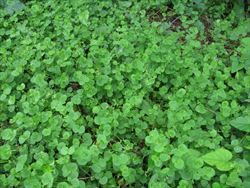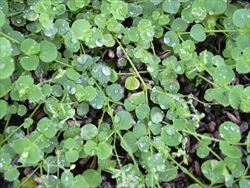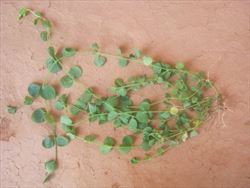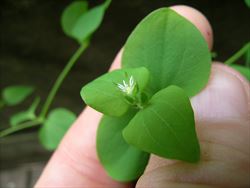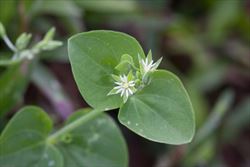- Widespread. In Australia, Fiji, French Polynesia New Caledonia, PNG.
- Aggressive, creeping weed of vegetables, root crops, pastures, lawns, roadsides, riverbanks, forest margins, secondary forests, and plantations. High seed production, fast development, and tolerant of many soil types. A threat to native vegetation.
- Smooth, weak, creeping stems, up to 1m, branching, rooting at nodes. Leaves round/heart-shaped, in opposite pairs, on short stalks. Flowers white, stalks 3-5mm long, at ends of forked stems, and in leaf axils. Five petals, deeply lobed, with sepals beneath. Flattish seeds.
- Spread: vegetatively on creeping stems that root; seed via wind and water; a contaminant of hay, and on vehicles and livestock. Long distance from its use as a food and in traditional medicines.
- Biosecurity: risk is seed as a contaminant of other species. Check imported machinery/vehicles. Check hay. Available on Internet.
- Biocontrol: none.
- Cultural control: hand-weed; slashing (but stem pieces regrow) – cultivation in pastures more effective in dry season. Mulch (5-10cm) to prevent seedling growth. Clean soil and seed from machinery/vehicles. Ensure hay is free from tropical chickweed.
- Chemical control: in Australia, napropamide; cyanazine; dicamba; metribuzin; oxyfluorfen; terbutryn. In Fiji, glyphosate; dicamba and 2,4-D.
Pacific Pests, Pathogens and Weeds - Online edition
Pacific Pests, Pathogens, Weeds & Pesticides
Tropical chickweed (510)
Tropical chickweed; it is also known as heartleaf drymary, whitesnow, West Indian chickweed.
Drymaria cordata. It is a member of the Caryophyllaceae.
AUTHORS Grahame Jackson & Makereta Ranadi
Information from CABI (2019) Drymaria cordata (tropical chickweed). Crop Protection Compendium. (https://www.cabi.org/cpc/datasheet/20020); Fern K (2021) Tropical Plants Database (http://tropical.theferns.info/viewtropical.php?id=Drymaria+cordata); and Eat the weeds (http://www.eattheweeds.com/drymaria-cordata-kissing-cousin-chickweed-2/); and from West Indian chickweed - Drymaria cordata. (http://www.it2.fr/wp-content/uploads/2014/11/DOC_IT2_2014-Fiche-manuel-BGM-n11-Petit-mouron_ANG_BD1.pdf). Photo 1 Harry Rose, South West Rocks, Australia. (https://en.wikipedia.org/wiki/Drymaria_cordata#/media/File:Drymaria_cordata_flower1_(13835011814).jpg). Photo 2 Krish Dulal. Uprooted Drymaria cordata found in Panchkhal Valley, Nepal. Wikimedia Commons. (https://commons.wikimedia.org/wiki/File:Drymaria_cordata_02.JPG). Photo 3 Forest and Kim Starr. Starr Environmental. The low mats of growth make a good ground cover. (http://tropical.theferns.info/plantimages/a/d/ad8f08750edc9898bc9c29464b50d7048ba06276.jpg). Photo 4 Harry Rose. The plant can form extensive mats of growth. (http://tropical.theferns.info/plantimages/6/f/6f89a569623a0df6abb044812b59e2077c985cff.jpg). Photo 5 O.M. Montiel. Close up of small flowers. (http://tropical.theferns.info/plantimages/8/0/804851ac2483c6c841fe5f45b886f5b1755fce2a.jpg)
Produced with support from the Australian Centre for International Agricultural Research under project HORT/2016/185: Responding to emerging pest and disease threats to horticulture in the Pacific islands, implemented by the University of Queensland, in association with the Pacific Community and Koronivia Research Station, Ministry of Agriculture, Fiji.
